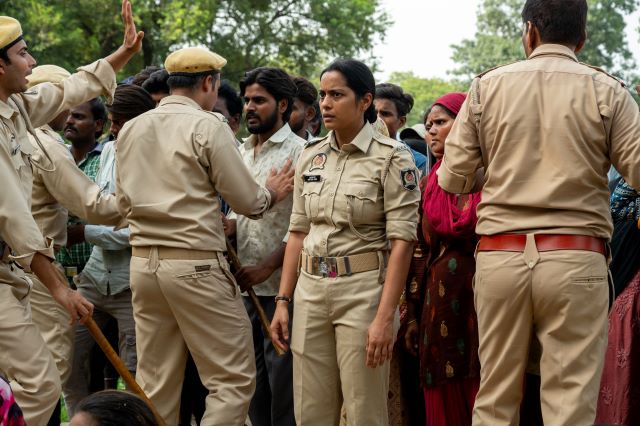
Santosh – UK’s Nomination for the Oscars – Packs a Powerful Punch
Long after the film is over, you will be haunted by Santosh’s amazing eyes – anguished, puzzled, devastated – occasionally hopeful – as she enters a harsh world not of her own making. Shahana Goswami, who plays Santosh, makes you forget that she is an actor and that this is a movie as you are sucked into the vortex of a real India which exists in the cacophony of big cities, everyday small towns and villages where nothing seems to happen – a very raw slice of life which is not black or white but all shades of gray.
Santosh – the trailer
Santosh has been married only two years when her constable husband is killed in a riot and she, a housewife, finds herself literally in his shoes, taking on his police job thanks to a compassionate scheme by the government for widows. On the job she learns the many twists and turns of the world of justice and the brutal back stories of victims. In a world of inequities buffeted by the powerful, justice isn’t always served and there are harsh truths to be learned every day. As her superior officer tells the newbie constable, “There are two kinds of untouchables in this country – the ones people don’t want to touch and the others who can’t be touched.”
We all get invested in Santosh’s journey through the rough terrain of police brutality and comprise. Will she emerge with her moral compass intact or will it be damaged?
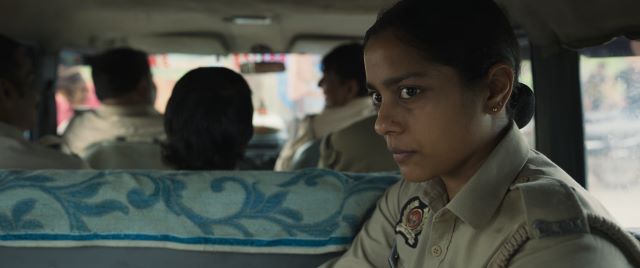
Director Sandhya Suri, who has also written the screenplay, moves subtly but involves you in minor lives which become important as part of the emerging narrative. It is very much show rather than tell – Santosh rarely speaks – her eloquent face mirrors her inner conflicts as she struggles not to sink into the quagmire of corruption and brutality. The tale takes on so many issues – the status of women, caste, corruption, the helplessness of poverty – it makes you think.
Suri is a documentary filmmaker and this is her debut feature film. It has already won two British Independent Film Awards and is the UK’s entry for the Oscars.
While Suri has directed the film and written the screenplay, its producers are James Bowsher, Balthazar de Ganay, Alan McAlex, Diarmid Scrimshaw, Eva Yates, Mike Goodridge and the music is by Luisa Gerstein.
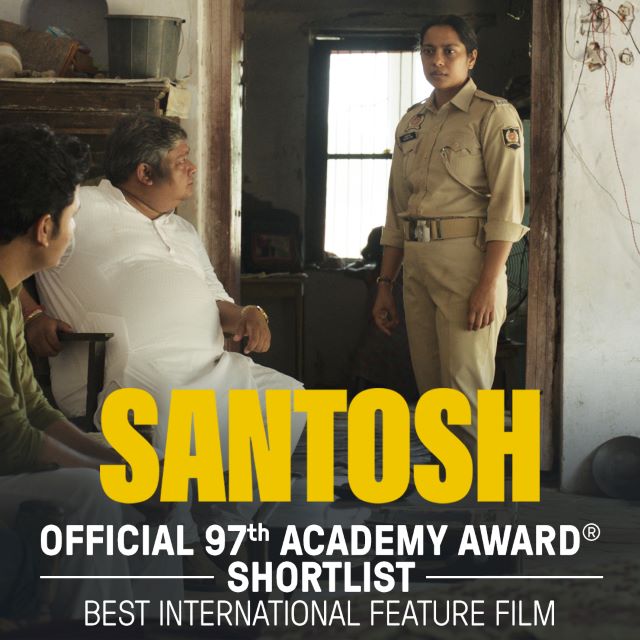
Right from the first scene you are involved in Santosh’s life as it hurtles down a rabbit hole of violence and disparity. Sandhya Suri’s Santosh won two British Independent Film Awards and is UK’s submission for the Oscars. As The Hollwood Reporter noted, “The British-Indian director’s background is firmly in documentaries and Santosh, in its very early stages, was going to be just that: a forensic look at the rife violence against women in India, the deeply embedded corruption within its police force and the powerless women forced to watch on.” But as Suri admitted, “I couldn’t figure out how to do it as a documentary form because it was just too horrific. I dropped the project.” Thus was born this powerful first film about a woman’s coming of age in the corrupt world of police brutality as she gets mired in solving the murder case of a minor Dalit girl whose sexually violated body has been found in a well.
Face to Face with Director Sandhya Suri of ‘Santosh’
Hear the interview in Sandhya’s own voice – you are in the room!
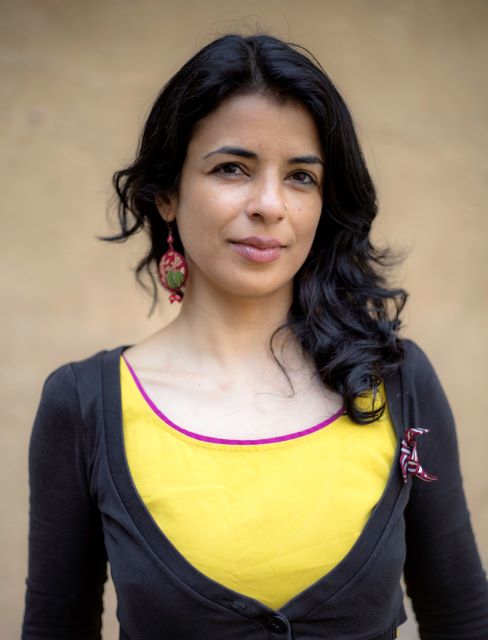
1. Tell me about yourself – you were born and grew up in the UK; How did you manage to stay so close to your Indian roots?
Hi. This is Sandhya, and this is for lassi with Lavina. The first question is about myself and how I managed to stay so close to my Indian roots. I mean, I grew up with a father who was so so nostalgic, so missing his homeland. There was so much yearning when, you know, he’d come from India, from up in the 60s to England, and first by America and then in England. And he would often, you know, be listening to his golden oldies and thinking about India and talking about India, both with a lot of love, but also sometimes critically, because of that love, which I understood through him, what that care for your motherland can mean. And basically, I suppose I inherited that. I would go to India all the time, at least, sort of once a year. You know, once I became my own adult at 18, usually with a camera in my hand, exploring, looking for stories, because the stories come so easily to me in India and here in the UK, it’s always been difficult for me to find things I want to talk about. But India was just so easy for me. And also, I think having the camera in my hand and exploring India through my filmmaking is a way in which I can have a relationship to India which feels, you know, really deep. And not just going back for shaadi or khana or shopping – it just gives me an extra layer to feel that bond deeply.
2. Were you always passionate about cinema, as a child?
I mean it, it’s my father against my father’s legacy. My father was a doctor, but when he came to England in the 60s, he was very dissatisfied with the means of communicating with family back home. He found telegrams were expensive and the phone was not reliable. And so what he did was he bought these two Super Eight cameras and two reel to reel recorders, two projected screens, and he shipped one set back to India, and he kept the other set in England. And we basically made film letters for one another for over 40 years.
So I would often be splicing and adding commentary and, you know, all these types of things. In the beginning, my father was only sending images of snow. And, you know, he’d put, like, Lara’s theme from Dr Zhivago on it and send it back to India. They’d send something back asking for some more funny bitty, some more funny things about the UK. So we were always making films and and I think that that’s part of it, but I always had that creative bent. I just wasn’t sure quite how I would express it. The idea was that maybe I would be an author, and so I knew I would study something different, that wasn’t literature or or media, something where I wouldn’t have to analyze the art form that I love, but that I would just go and make it at a postgraduate level of film school. That’s what I decided later on and and then I was living in Japan teaching English. After I finished my math degree, because I just chose a degree that was, you know, interesting and would use my mind in a different way, I graduated in pure math. I went to live in Japan teaching English. And when I was there, I went to a great film festival called Yamagata Documentary Film Festival. And I just decided, okay, this is amazing. My mind was opened. I bought a camera in Tokyo. I went, I made a film, and I applied to the National Film and Television school in the UK, where I got in, and that was the beginning of the story.
Which were the concerns which moved you the most in selecting the stories you would tell the world.
I mean, I think as an artist, you know, ideas often brew so, as a woman filmmaker, as a woman artist, you know, for many years, I was thinking about how to talk about violence against women in a way which is intelligent and brings understanding in which I also can explore, explore that and understand the questions that I want to ask and try to get deeper understanding in the subject. Rather than just, you know, showing a theme or showing what is bad. I was trying to look at ways to bring understanding to a subject matter. So that was a genesis theme of this film, although that also, then, you know, spreads out into the many other fault lines of of society. I think the thing is, you know, it’s always about an emotional response, about what we feel deeply and what we want to say as filmmakers, you know, I wouldn’t necessarily be a great filmmaker to make a film that was, you know, just entertainment. I feel like to make a film, I have to have something deeper behind it.
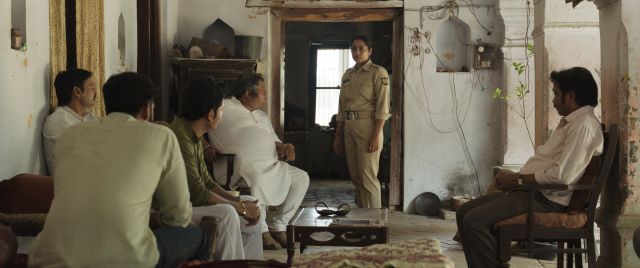
Asking why I made the jump from documentaries to features, or how it was just really an organic process in that while I was trying to figure out how to address this theme of violence against women, I had seen an image of a police woman facing female protesters, angry and full of rage after the Nirbhaya case in Delhi, and I saw that image. It wasn’t about the case, to say it was about the image of this constable who was facing the women, and I thought she was such an interesting end point to explore violence. And obviously, once I knew that I was making my, you know, heroine, a police woman, then it becomes very impractical to think about making a documentary. So I knew then that I would be making a fiction and that it would be a very steep learning curve.
How did you select Shahana Goswami – what quality sold you on her ability to carry this film? The choice of Sunita Rajwar was also flawless for the interaction between the two.
Well, Shahana came in very late in the casting process, mainly because she had been a little bit outside the age bracket that we were thinking of. But I just knew as soon as she walked in the room that she really held all the shades of the Santos I had written. I was confident she would be able. She was already that, you know, because you could have a Santosh who was just innocent, a, you know, and like, very shocked by everything she sees. But my Santosh was a little bit more ambitious. She’s trying to watch, she’s trying to figure out this new world. She’s trying to see what is justice. She’s also trying to see how she can get ahead in it. So she’s sort of, she has a very strong feeling of intelligence as a character. And Shahana, absolutely was that whilst having this sort of this great physicality that I just found she would be iconic in that uniform, I could imagine a life of passion that she had led.
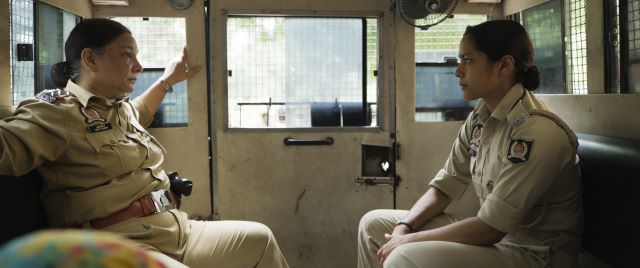
She’s very good at holding things, you know, behind the top layer. You know, we can feel what’s underneath in her, and that was very important in this character, who doesn’t, you know, scream and shout a great deal, but we need to be emotionally close to her. And then Sunita. Just honestly, I saw Sunita probably in a comedic role, maybe in Panchayat, I think it was, and just her face I fell in love with automatically. I thought she brought so much humanity to Sharma, and she helped us to make Sharma somebody so real, somebody so relatable, rather than just this sort of scary figure who could be more of an archetype. So she really made her real, and then I did a chemistry test between the two of them, and that was perfect.
Tell me about the way you selected the rest of the cast, many of them non-actors who looked as if they were part of a real story in a real small town.
I mean, this was so important to me, just because I just have a basic rule on set, you know, making my first fiction is, do I believe it, or do I not believe it? This is my main question for everything, a piece of dialog, a performance. And if I see, you know, if I see some of these things that I’ve written, some of these roles, which come from, all my travels, all my observations, all my research, many of these people, then I want to know that it feels like what I’ve felt seen and engaged with in my real life. So that’s most likely to come from someone who does that job or is already in that place and of that place. And so it’s just it’s sort of natural to cast those people. I think we see it a lot in Indian cinema also, but in a way which may be more background, this sort of realism of real faces. And I was very sure why shouldn’t these smaller people playing these smaller roles? Why shouldn’t they be speaking also, you know, why shouldn’t they also carry the scene like I didn’t think it was impossible, and nobody let me down in that everybody just felt very real, performed really well. And, yeah, I’m very, very happy, because I think that is what lends a great deal of authenticity to the film.
Why is this story of corruption and redemption in small-town Indian striking such a chord with audiences from Paris to Tokyo to London?
You know, it’s been really fascinating to see this film play out in so many different places. Obviously Santosh and our proximity to that character, because, you know, we’re literally standing by her shoulder watching the world, and our eyes are opening with hers. So there is a very strong emotional connection through her, which transcends, you know, which is a human, universal story. But what’s also been interesting is how thematically the film seems to be resonating with a lot of people outside of India, and I think that’s precisely because the themes of corruption, including in police institution, institutions such as the police and also impunity, are not they’re not particular only to India. Things may be closer to the surface, but many of these fault lines which are in the film, not all of them, but many of them. They exist elsewhere also. And I think that, I think that has really resonated with people that we’re dealing with global issues. But ultimately, it is a story of a woman and the trajectory of her grief in a very complex sort of coming of age of a grown-up woman, an empowerment story which has a sort of a darker side as well.
How did you acquire the heavyweight crew – what moved them to be a part of this venture?
I think it’s always about the script. It’s always, always about the script. If the script is good, I know the the the value of a good script, everybody in the industry does. And I think that that is what will make move people, you know, that is what you’ve got until everything is real on, you know, and on the screen that is, that is the one thing that everybody is working from. So I think if you feel that there’s a confidence in that script, it doesn’t matter if that’s a first time fiction filmmaker or not, because I think people reading it can feel that confidence, and then they too, feel excited to make it ambitious. If the script is ambitious, and everybody gets behind a vibe of, you know, let’s, let’s go for it, because this was an ambitious film for a first feature. And, you know, I’m so grateful to everyone who who did get behind it.
What keeps you going in rough times?
What keeps me going in rough times, that’s a hard one. Of course, there’s always family, my daughter keeps me very strong. I think though it’s just about belief as well. It’s about plodding on, moving forward, step by step. This has given me a huge boost of energy to see the film so well received after such a long struggle. You know that if you just keep plodding on and keep doing things for the right reasons, then I feel confident that if the work is good, there will be place for it somewhere.
‘Santosh’ is the UK’s official entry for the Oscars. What’s next on the drawing board for you next on the drawing board?
Yes, we’re now in the shortlist of 15 films for the Academy Awards, which is amazing. For the next steps , I’m just concentrating on trying to to get back to to writing my next project. I have a next project. And, you know, enjoying that creative process again, which is about the work, because I think the rest hopefully the universe and audiences will take care of and I hope that they respond to the film we’re releasing. We released 27th of December in New York, and will be releasing in India in January, in March in the UK, a few other countries in between as well, I believe. So. I’m very happy at seeing audiences, and I’m looking forward to engaging with them, but also just sitting down at the writing table again and engaging in that other process too.
